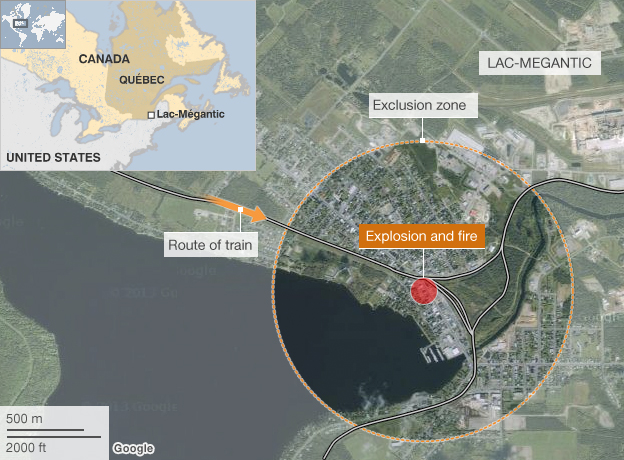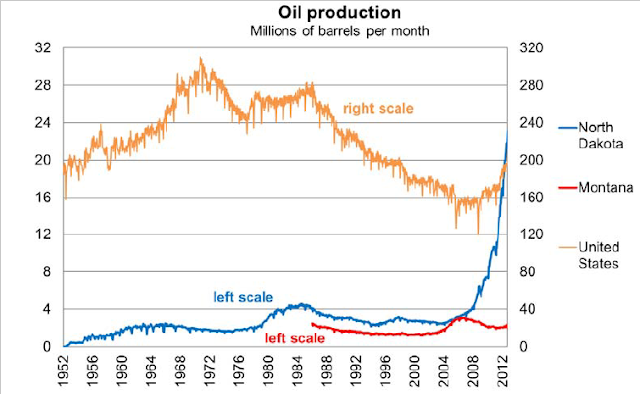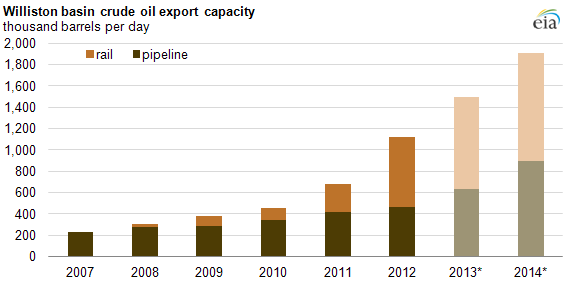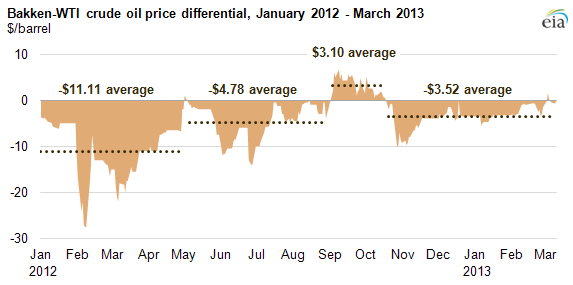Almost exactly like the 2010 movie "Unstoppable" which tells the story of a runaway freight train carrying hazardous chemicals, another unmanned 73-tanker runaway train full of crude oil also was passing through a small town of Lac-Megantic in Quebec, Canada on an early Saturday morning, July 6. However, in the movie, the runaway train was eventually stopped by two railroad workers (played by Denzel Washington and Chris Pine), sadly, this runaway train derailed and caused five tanker rail cars to explode in the downtown district of Lac-Megantic.
Loose Oil Market Remains Calm
What ensued was described as "a war zone with multiple blasts came over a span of several hours" in the town of 6,000, which is about 155 miles east of Montreal and about 10 miles west of the Maine border. The latest news reported 13 dead, 50 missing, and crews are still working to contain 27,000 gallons of light crude that spilled from the tankers and possibly into a near-by river.
Typically, this kind of oil related disaster would have sent at least a spike or two to the oil price. However, attesting to the current loose and already over-supplied environment, traders and crude oil market hardly even blinked.
Bakken Oil Rail Shipping Economics
The train, which belongs to Montreal Maine & Atlantic (MMA), reportedly was shipping the crude oil from the Bakken Field (in Williston Basin) in North Dakota towards Maine. Some of you may be wondering how this trade could make any economic sense considering shipping by rail adds about $20 a barrel, on average, to the cost of oil. Here is how the math works:
The modern day shale revolution has helped elevated North Dakota as well as the U.S. to be the most prolific oil producing regions in the world, but also has caught the energy and oil transport industry by surprise. 
The lack of sufficient pipeline takeaway capacity was a major factor behind Bakken oil priced at a discount of $28 a barrel to NYMEX WTI in February 2012. Mind you that there’s also an additional WTI-to-Brent discount of up to $25/bbl at some point during 2012, owing largely again to the pipeline constraint leading to the oil glut at Cushing, OK, artificially depressing the price of NYMEX WTI.
The light and sweet Bakken crude is actually more suited for the refineries on the U.S. East Coast since plants there are mostly older and require higher grades of crude oil such as Bakken’s as feedstock, whereas the refineries on the Gulf Coast are geared more towards handling cheaper and heavier crude grades.
This unprecedented huge spread between the land-locked Bakken, WTI and Brent has made shipping crude oil by rail across Maine to a refinery in the Maritimes an attractive alternative. For example, by mid- 2012, both Pan Am Railways and MMA were looking to move vast amounts of crude to an Irving Oil refinery in St. John, New Brunswick.
Pipeline’s Loss Is Rail’s Gain
So while most of the environmental attention has been focused on boycotting new pipelines like the Keystone XL, railroad companies such CSX Corp. (NYSE: CSX) and Canadian National Railway (NYSE: CNI), hurting from decrease coal volume and a weak economic recovery, have emerged as significant players in the oil transport business at the Williston/Bakken field.
The North Dakota Pipeline Authority now estimates that 71% of the crude oil moved out of the Williston Basin was transported on rail cars while only 20% of it was carried in pipelines. Rising production and legislative gridlock on new pipelines means rail would have an increasing market share of transporting oil out of Williston basin. 
Pipeline, Rail, or Truck?
Within the continental U.S., pipeline, rail, and truck are the three main transport modes for crude oil. Pipelines are the most cost-effective to transport crude oil in the United States, but they require heavy capital investment with many regulatory hurdles. Rail, on the other hand, is not as big an environmentalists’ target as oil pipelines, and is cheaper than truck in transporting oil. Ultimately, a legislative veto of pipeline projects like Keystone XL actually has pushed the underlying oil transport need and investment money towards rail.
Energy Security & Infrastructure
While the surging shale oil production has made “energy independence” seem more feasible for the U.S, it also has exposed the lag in the country’s infrastructure to transport new domestic production in a safe and the most cost-efficient timely manner to the end users, which is the more important aspect of achieving the ultimate energy security.
According to EIA, Bakken pipeline capacity will increase to more than 650,000 bbl/d and rail capacity to nearly 900,000 bbl/d in 2013. The price spread between Bakken oil, WTI and Brent has narrowed since 2012, and the trend is expected to continue. As this oil rail trade gradually becomes uneconomical, the fact remains that the U.S. needs more pipeline infrastructure in order to keep the nation’s energy cost in check. 
This rail disaster at Lac-Megantic most likely will not slow down the rail development, but it is also time for the U.S. government to put idealism, politics and lobbying money aside and let the pipeline do what they do. It is bad business if we have to import foreign oil because the country lacks more cost-competitive infrastructure to transport domestic oil production.
- English (UK)
- English (India)
- English (Canada)
- English (Australia)
- English (South Africa)
- English (Philippines)
- English (Nigeria)
- Deutsch
- Español (España)
- Español (México)
- Français
- Italiano
- Nederlands
- Português (Portugal)
- Polski
- Português (Brasil)
- Русский
- Türkçe
- العربية
- Ελληνικά
- Svenska
- Suomi
- עברית
- 日本語
- 한국어
- 简体中文
- 繁體中文
- Bahasa Indonesia
- Bahasa Melayu
- ไทย
- Tiếng Việt
- हिंदी
Pipeline vs. Rail: Canada Oil Train Crash
Published 07/10/2013, 12:27 AM
Updated 07/09/2023, 06:31 AM
Pipeline vs. Rail: Canada Oil Train Crash
Latest comments
Loading next article…
Install Our App
Risk Disclosure: Trading in financial instruments and/or cryptocurrencies involves high risks including the risk of losing some, or all, of your investment amount, and may not be suitable for all investors. Prices of cryptocurrencies are extremely volatile and may be affected by external factors such as financial, regulatory or political events. Trading on margin increases the financial risks.
Before deciding to trade in financial instrument or cryptocurrencies you should be fully informed of the risks and costs associated with trading the financial markets, carefully consider your investment objectives, level of experience, and risk appetite, and seek professional advice where needed.
Fusion Media would like to remind you that the data contained in this website is not necessarily real-time nor accurate. The data and prices on the website are not necessarily provided by any market or exchange, but may be provided by market makers, and so prices may not be accurate and may differ from the actual price at any given market, meaning prices are indicative and not appropriate for trading purposes. Fusion Media and any provider of the data contained in this website will not accept liability for any loss or damage as a result of your trading, or your reliance on the information contained within this website.
It is prohibited to use, store, reproduce, display, modify, transmit or distribute the data contained in this website without the explicit prior written permission of Fusion Media and/or the data provider. All intellectual property rights are reserved by the providers and/or the exchange providing the data contained in this website.
Fusion Media may be compensated by the advertisers that appear on the website, based on your interaction with the advertisements or advertisers.
Before deciding to trade in financial instrument or cryptocurrencies you should be fully informed of the risks and costs associated with trading the financial markets, carefully consider your investment objectives, level of experience, and risk appetite, and seek professional advice where needed.
Fusion Media would like to remind you that the data contained in this website is not necessarily real-time nor accurate. The data and prices on the website are not necessarily provided by any market or exchange, but may be provided by market makers, and so prices may not be accurate and may differ from the actual price at any given market, meaning prices are indicative and not appropriate for trading purposes. Fusion Media and any provider of the data contained in this website will not accept liability for any loss or damage as a result of your trading, or your reliance on the information contained within this website.
It is prohibited to use, store, reproduce, display, modify, transmit or distribute the data contained in this website without the explicit prior written permission of Fusion Media and/or the data provider. All intellectual property rights are reserved by the providers and/or the exchange providing the data contained in this website.
Fusion Media may be compensated by the advertisers that appear on the website, based on your interaction with the advertisements or advertisers.
© 2007-2025 - Fusion Media Limited. All Rights Reserved.
